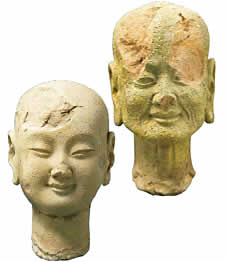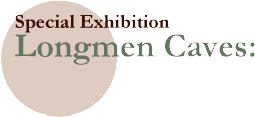| Sponsored by |
|
MIHO MUSEUM
The Asahi Shimbun
Japan-China Friendship Association
Foundation for Cultural Heritage
Commitee for Art Exhibitions of the Longmen Grottoes
Longmen Caves Research Institute |
| Supported by |
|
Institute for Archaeology, Chinese Academy of Social
Sciences
Embassy of the People’s Republic of China in Japan
Ministry of Foreign Affairs
Agency for Cultural Affairs
Art Research Foundation
National Federation of UNESCO Associations in Japan |
|
| The construction of the Longmen Caves, beginning
in the Northern Wei Dynasty, spanned over a period of 400 years from the
Eastern Wei to the Western Wei, Northern Qi, Sui, Tang, until the Northern
Song Dynasties. The construction reached its apex during the Northern Wei
and Tang Dynasties. According to the Longmen Caves Research Institute, among
the 2,345 caves along the banks of the Yi River, approximately one third
of them were built in the Northern Wei Dynasty, while most of the remaining
caves were carved out during the Tang Dynasty. |
 |
| The Central Binyangdong Cave |
The Binyangdong Caves are located on the northern side of the West Hill
of the Longmen Caves. Three caves form the Binyangdong Caves; the central
cave was completed in the Northern Wei Dynasty, while the construction of
the north and south caves were not completed until the Tang Dynasty. |
| These caves are believed to correspond
to caves that Emperor Xuanwu had originally commissioned in memory of his
parents, Emperor Xiaowen and Empress Wenzhao, at the beginning of the Jingming
era (circa 500 A.D.) on Mount Yique, south of Louyang. However, due to difficulties
in construction, the work did not progress as planned, and in Zhengshi 2
(505), the scale of the caves was reduced. Though later during the Yongping
era (508-512), the project continued and came to include a third cave for
Xuanwu himself. Early records tell us that the project took the efforts
of 802,366 people from its conception in the Jingming era to its completion
in the sixth month of Zhengguang 4 (523). |
 |
Head of a Bodhisattva
from
the Central Binyangdong Cave
Northern Wei Dynasty
Height 92.0 cm Limestone
Osaka Municipal Museum of Art
(Gift of Mr. Jiro Eguchi) |
|
| This bodhisattva head came from the Central Binyangdong
Cave. There are bold features, expressive of a bright and energetic feeling
not seen in the subtle mysteriousness found in other Northern Wei sculptures
from the Longmen Caves. |
| |
Monk Heads Excavated from
the Yongningsi Temple in Louyang
Northern Wei Dynasty
Height 14.6 cm (Elder Monk); 13.7 cm (Young Monk)
Institute for Archaeology, Chinese Academy of Social Sciences |
|
 |
In Taihe 18 (494), at the age of twenty-eight,Emperor Xiaowen
moved the capital of the Northern Wei Dynasty to Louyang from Pingcheng
(Datong), where it had previously lasted for a hundred years. At this time,
the government also planned to transfer the seven-story pagoda, known for
its beautiful tiled roof, at Yongningsi Temple in Pingcheng to Louyang.
Although it took many years, finally, from Xiping 2 (516) to Shengui 2 (519),
the pagoda was moved to Louyang and enlarged to a towering nine-story pagoda.
These two heads of an old monk and a young monk
were found there. Their facial expressions transmit the brilliant liveliness
seen in sculptures of the Northern Wei Dynasty.
|



